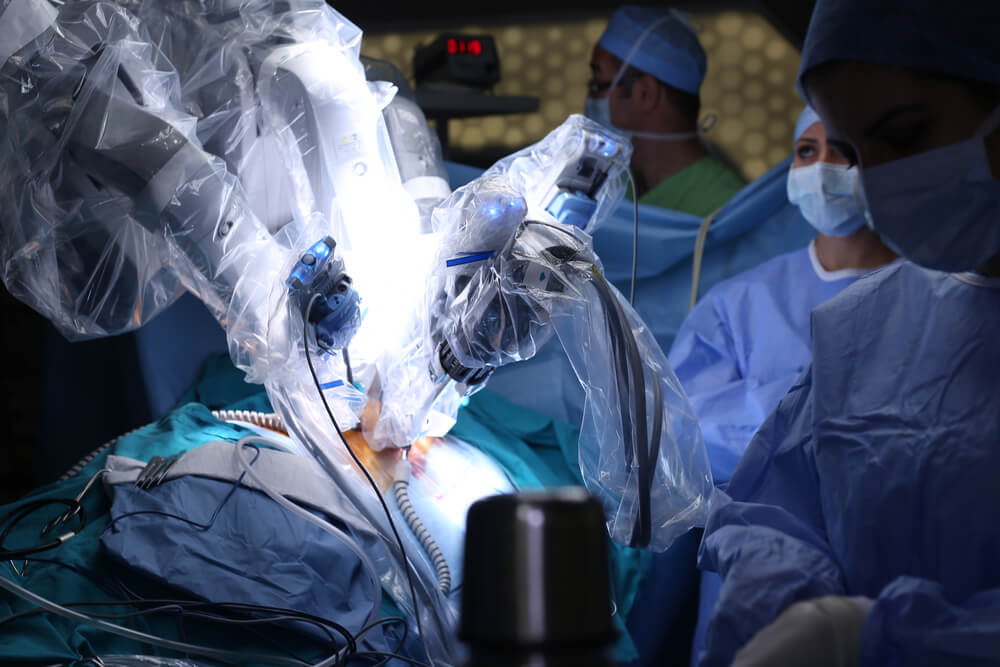As the name suggests, minimally invasive surgery is one that patients can undergo with minimal invasions on their bodies. Essentially, the surgeon will make just a few tiny cuts and utilize other tools, robotic tech, and cameras to perform the surgery without much more cutting and tearing of the skin and muscle. In that respect, the patient is bound to feel less discomfort and pain during the recovery as the recovery itself should be quicker compared to the recovery period from a traditional surgery (with one larger open cut), and the stay in the hospital should be considerably shorter.
There are two main types of minimally invasive surgery: robotic and non-robotic. If you want to learn more about both, keep on reading.
What’s Robotic Surgery?
Robotic surgery, also known as robotic-assisted surgery, is a minimally invasive surgical procedure that utilizes an electronic tool resembling a computer. This tool (or station) allows the doctor to manage, monitor, and control a special HD camera and robotic arms used for surgery performance.
In order to perform this particular type of minimally invasive surgery, your doctor will have to do several things. These steps include the following:
- Administering an adequate amount of anesthesia to ensure the patient is thoroughly asleep.
- Providing and setting up tools station that the robotic arms will use for the surgery.
- Creating small incisions for these tools to be used and inserted in.
- Using these tools and inserting them into the incisions.
- Making another incision that will be used for an endoscope (a thin tube with an HD camera).
- Performing the surgery with the assistance of robotic arms while checking the view on the camera.
- Removing the tools for the incisions once the operation is completed.
- Proceeding to stitch the incisions shut.
Uses for the Robotic Surgery
In general, robotic-assisted surgery has many uses, especially when the nature of the procedure involves challenging and risky areas to reach through traditional surgery. These include conditions such as:
- Lung tumors
- Heart valve issues
- Range of urological problems such as bladder, kidney, and prostate cancer, kidney stone and cysts, etc.
- Gynecologic issues such as endometriosis, ovarian cysts, and cancer, uterus removal, etc.
- Stomach, liver, pancreatic, colon or rectal cancer
- Gastric bypass due to obesity
- GERD
- Gallbladder infection or stones

Benefits and Risks of Robotic Surgery
Benefits
The main benefit of robotic-assisted surgery is the ability it provides to the surgeon to clearly see the entire targeted area in 3D. The software known as “motion scaling” is typically used to deal with the most delicate movements and techniques.
Compared to traditional surgery, the robotic one has many other benefits, such as:
- Minimal blood loss
- Minimal skin, muscle and tissue damage
- Quicker recovery time
- Less pain and discomfort
- Reduced infection risk
- Minimal scarring
Risks
It might be minimally invasive, but surgery is still a surgery, and even smaller incisions can pose some health risks, mainly in regard to general anesthesia and infections. What’s more, robotic-assisted surgery typically lasts longer than traditional procedures as it takes some time to set up and manage all the necessary equipment before the procedure even starts.
It’s also possible for the doctor to make a decision during the robotic surgery that they need to utilize the traditional procedure to finalize the operation if the patient’s condition so requires. In case it comes to this “last resort”, patients will have to prolong their hospital stay, take longer to recover, and expect a more visible scar.
What’s Non-Robotic Surgery?
Non-robotic surgery is a rather similar technique to robotic one. The primary difference is in the robot part, as the surgeon won’t use robotic arms to perform surgery but their own. Non-robotic minimally invasive surgery can be laparoscopic, endoscopic, or endovascular and is often referred to as laparoscopy, laparoscopic surgery, or endoscopic surgery.
The steps in non-robotic surgery are as follows:
- Using general anesthesia to keep the patient asleep.
- Creating small incisions for tool implementation.
- Inserting the tools into those incisions.
- Making another incision and inserting the endoscope through it in order to track and gain a good view of the procedure and targeted field. If the area that’s being operated on allows it, the endoscope could also be inserted through the nose or mouth.
- The surgeon performs the surgery with their own hands while monitoring the endoscope’s view on the screen.
- Once the procedure is completed, the surgeon removes the tools from the incisions and proceeds to stitch them shut.
Uses for the Non-Robotic Surgery
Those conditions listed under potential uses for robotic surgery can also be dealt with non-robotic minimally invasive surgery. What’s more, the non-robotic procedure can also effectively help with other conditions, such as:
- Vascular disease and varicose veins
- Neurological/spinal conditions relating to spinal cord/discs
- Brain tumors
- Brain/spine injuries
In general, diagnostic laparoscopy is the go-to procedure when it comes to the careful examination of the abdomen and organs located in the area and can prove essential in pinpointing tricky gynecological issues, especially after menopause. For instance, cysts and polyps can cause a range of different issues and complications but can easily be removed with laparoscopy.
Benefits and Risks of Non-Robotic Surgery
Benefits
Similar to the robotic surgery, benefits of the non-robotic procedure involve greater precision and view during the operation, less discomfort and pain, quicker recovery time, lower chances of further complications as well as minimal scarring.
Risks
Again, the biggest risk involving non-robotic minimally invasive surgery has to do with potential complications with general anesthesia and infections. Also, it might turn out that the only way to finalize the procedure successfully is to switch to the traditional operation technique. This too means that the hospital stay could end up longer than previously expected, with longer recovery time and a larger scar to show for it.
It’s crucial that you discuss the best course of action with your doctor in regard to your overall health, a particular condition that requires surgery as well as any concerns and worries you might have. What’s more, you have to address the question of general anesthesia as there are many different factors that will affect the correct dosage and your ability to go through with it safely.
It’s true though that minimally invasive surgery is more appealing to patients due to the mentioned benefits, especially considering that the utilized technology for both robotic and endoscopic procedures is advancing rapidly, you still have to confirm that you’re 100% a good candidate for it.
If you have any health concerns, don’t hesitate to reach out to us at Women’s Care of Bradenton where we provide top-quality Family Practice and Obstetrics and Gynecology care. We offer a range of different services, which includes minimally invasive surgery in the Bradenton area. A great majority of candidates for laparoscopy in Bradenton FL readily chose to place their trust in the professionals and experts of the Women’s Care of Bradenton clinic, not only for the latest equipment and technologies we employ, but also the comfortable and pleasant atmosphere every single member of our staff strives to create and contribute to. After all, our goal is to address the entire well-being of women and provide unapologetic care, treatment, and service that every lady deserves.


